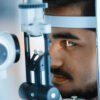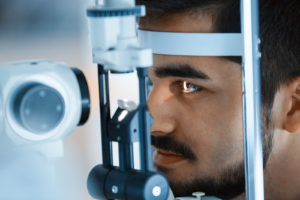
What’s a Comprehensive Eye Exam?
Just like any other part of our body, we need to have our eyes checked by professionals. Unfortunately, many people skip out on this crucial step in healthy living. Too often, people think that if they can see well, their eyes must be healthy. They ignore the advice to get a comprehensive eye exam.
Sight can be deceiving. Many threatening eye diseases that can cause severe vision loss fly under the radar until it reaches the point of no return. After that, it can be difficult to treat your eyes. So, you may have to live with impaired vision.
Though that might seem scary and a little doomsday-like, there is a very simple solution: a comprehensive eye exam.
Not to be confused with an eye screening, which only verifies how good your eyesight is, a comprehensive eye exam delves deep into the eye to check the inner layers of the eye for potential harm and budding diseases.
What to Expect
Comprehensive eye exams are just that – comprehensive. This exam is the equivalent of a general checkup with your physician. Your general physician will ask you some questions and do a few tests to make sure that everything is in order.
Comprehensive eye exams work on the same principle. They check to see if there is anything glaringly wrong but they don’t check for specific diseases. If serious diseases are discovered during a comprehensive eye exam, you will likely be referred to a specialist who can fully diagnose your condition.
The entire exam can take up to an hour to administer.
Visual Acuity Tests
One of the first things checked during a comprehensive eye exam is a person’s visual acuity. Although this test does not check for any specific disease, poor visual acuity can be a sign of a refractive error.
Visual acuity tests are the most well-known eye tests. These tests are commonly used in schools as part of eye screenings. A child needs sharp visual acuity to properly learn to read and write.
The most common visual acuity test, and the one you’ll most likely be subjected to, uses the Snellen Eye Chart. You’ll be asked to stand 20 feet away from the chart and read the letters aloud. You may sometimes be asked to cover one eye to test each eye individually.
Depending on how far you get in the chart before you can no longer make out the letters will determine your visual acuity. 20/20 visual acuity is the benchmark and the standard visual acuity number.
Refractive Error Testing

Some of the most common vision impairments come from refractive errors in the lens of the eye. These errors include myopia, astigmatism, and hyperopia.
If your doctor diagnoses you with a refractive error, they will need to fit you with a pair of prescription glasses.
To find the right prescription your doctor will use a device called a phoropter. This device consists of different lenses that will help determine your prescription. different lenses like slides until you get to a slide that allows you to see clearly.
Autorefractors and aberrometers are two other devices that can be used to determine a person’s prescription. Both of these instruments require your chin to be stabilized as you look at a pinpoint of light or a detailed image. Your doctor will determine your prescription based on how the light is refracted by the eye.
This method is often used with children and people who have difficulty sitting still. This method is quicker than the manual test with the lenses and has become very accurate in recent years due to the evolving technology.
Slit Lamp Exam
Refractive errors aren’t the only vision impairments sought out during a comprehensive eye exam. Eye doctors are always on the lookout for early signs of more severe eye diseases.
Many eye diseases like glaucoma, diabetic retinopathy, macular degeneration, and cataracts have irreversible consequences once the disease has progressed past a certain point. Some diseases, like glaucoma and diabetic retinopathy, show no symptoms until the disease has progressed too far.
Slit lamp exams work to help doctors see the inner workings of the eye to make sure everything is in order. Slit lamps are vertical microscopes. You would have to place your chin upon a chin rest, while your doctor sits on the other side and peers through the slits to look into your eye’s layers.
Sometimes, doctors use a handheld version of the microscope to see parts of the eye such as the retina and the optic nerve.
Pupil Dilation Exams
Pupil dilation is not always part of a comprehensive eye exam. However, it will be used to check the eyes of people who are at risk of developing certain eye diseases. For example, people who have diabetes, pregnant women, and those with high blood pressure may need to have their pupils dilated.
Doctors use special eye drops to administer this exam. Doctors put the drops into your eyes and take about a half-hour to kick in. During this time, your eyes will become extremely sensitive to light because more light will be let into your eyes. You may also experience blurred vision.
Dilated eye exams are crucial in being able to see the back of the eye. This process allows the doctor to get a better look at the back layers than a slit lamp exam.
This exam is not always needed but is recommended for people over the age of 60. The pupils will take a few hours to return to normal. It’s important to have someone pick you up from your appointment.
Eye Exams for Children
Early on in childhood, doctors will test your children for color blindness.
A color-blind exam can include a variety of tests. Commonly, examiners ask children to read numbers and letters disguised in contrasting colors compared to the background.
Another test consists of a doctor showing the patient two different colors that are similar in shade to test the severity of the color blindness.
Doctors may use a cover test to see how your child’s eyes work together. The doctor will ask your child to focus on a point in the distance and cover one eye. Staring at the object, they will need to alternate covering each eye while continuously looking at the object.
If your child has trouble finding the object with the eye once uncovered, it may be an indication of amblyopia and strabismus. Whatever the case may be, your children need to get their eyes checked at least once a year.
Who Needs a Comprehensive Eye Exam?
Everyone needs eye exams! You can tell yourself that your vision is fine or that you’ll make an appointment when the weather is better. Yes, we’ve heard that excuse before. Don’t wait! Make an appointment today if you haven’t had a comprehensive eye exam in the past two years.
Children should visit the eye doctor every year until they reach adulthood at 18 years old. After this, you should go every two years. After the age of 60, you should have an eye exam every year or more frequently if you have any existing eye conditions or are at risk of developing eye diseases.
Our Rebuild Your Vision Ocu-Plus Formula Contains All 17 Vitamins, Minerals, and Herbal Supplements to Improve Your Eye Health!




Is there away too lower eye pressure?
I had a thorough eye exam last week. Instead of dilation he used a machine that takes a picture of the eye including the back of the eyes.
It actually gives a lot more info including the health of the arteries and whether there is a tumor in back of the eyes.
I get aural migraines so I always wonder about that.
The test cost an extra $39 but it’s well worth it.
I have astigmatism so I had to order prescription glasses, I got ones with Crizal Prevencia lenses that also include blue light protection since I will be using these glasses for reading and computer work. $300 with insurance
I have a comprehensive eye exam every September. I have dry eyes, so I use two kinds of eye drops every day. I will soon have to have cataract surgery.
I love to read both serious, Biblical books and a certain type of Christian fiction, so I am always trying to help my eyes by diet and the vitamins that I take and the drops that I administer every day. I realize, fully, that my diet can affect my eyes as well.